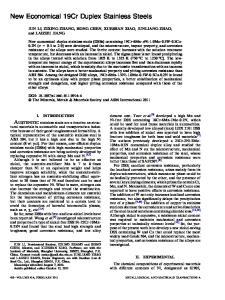Paraequilibrium Carburization of Duplex and Ferritic Stainless Steels
- PDF / 660,811 Bytes
- 10 Pages / 593.972 x 792 pts Page_size
- 30 Downloads / 311 Views
ODUCTION
PARAEQUILIBRIUM carburization of austenitic stainless steels at temperatures below ~750 K results in marked enhancement of the surface hardness, wear resistance, fatigue resistance, erosion resistance, and corrosion resistance[1–4] with essentially no loss of component ductility. Furthermore, dimensional changes of such carburized components are minimal during this conformal atmospheric pressure process. A 316L austenitic stainless steel subjected to paraequilibrium carburization at 743 K achieved surface carbon concentrations of ~12 at. pct.[1] The thermodynamic origins of the ‘‘colossal’’ paraequilibrium carbon supersaturation, in which carbide formation is kinetically suppressed, have been considered in some detail in our previous work.[2] These very high levels of metastable carbon supersaturation arise from the presence of carbideforming elements such as Cr and Mo, which greatly decrease the activity coefficient of carbon. Under equilibrium conditions, such elements promote carbide formation and reduce the carbon solubility to extremely G.M. MICHAL, F. ERNST, and A.H. HEUER, Professors, X. GU, Graduate Student, W.D. JENNINGS, Engineer, and H. KAHN, Research Associate Professor, are with Case Western Reserve University, Cleveland, OH 44106. Contact e-mail: [email protected] This article is based on a presentation given at the ‘‘International Conference on Surface Hardening of Stainless Steels,’’ which occurred October 22–23, 2007 during the ASM Heat Treating Society Meeting in Cleveland, OH under the auspices of the ASM Heat Treating Society and TMS. Article published online April 15, 2009 METALLURGICAL AND MATERIALS TRANSACTIONS A
low levels. However, at the low temperature of paraequilibrium carburization, the substitutional solutes are effectively immobile, which imposes the kinetic constraint that prevents carbide formation. On the other hand, the diffusion coefficient for interstitial solutes exceeds that for substitutional solutes by a factor of ~107,[5,6] which allows hardened ‘‘cases’’ tens of microns thick to be realized in industrially feasible times, with very high surface carbon concentrations. It is noteworthy that the resulting concentrations of carbon in austenitic stainless steels are significantly greater than values predicted by a compound energybased interstitial solid solution model using interaction parameters from the latest CALPHAD assessment of the Fe-Cr-Ni-carbon system.[7] As discussed previously,[2] the discrepancy between the measured and calculated solubilities of carbon in austenitic stainless steels arises because the CALPHAD Cr-carbon interaction parameters are not sufficiently negative at the low temperatures used for paraequilibrium carburization. If these discrepancies also exist for ferritic stainless steels, several intriguing possibilities can be imagined. First, the paraequilibrium solubility of carbon in ferritic stainless steels could be greater than the predictions made using the current CALPHAD Cr-carbon interaction parameters for a bcc matrix. Second, the paraequilibrium
Data Loading...











